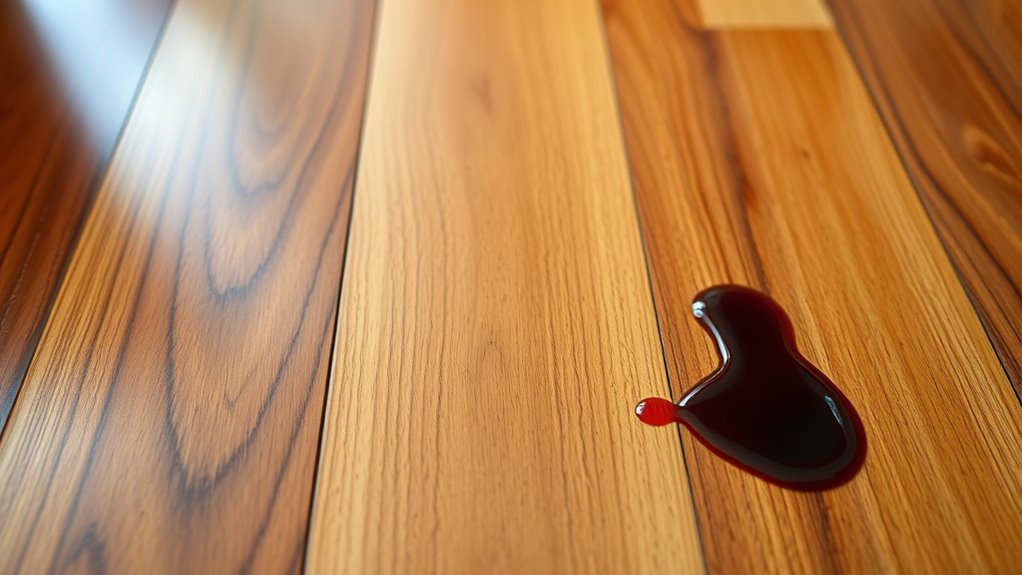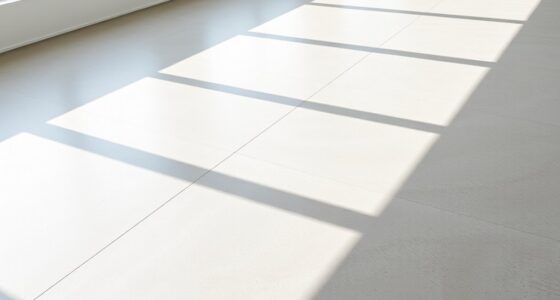To quickly remove coffee, wine, and grease stains from sealed hardwood, act immediately by blotting the spill without rubbing. For coffee and wine, gently wipe with a damp cloth mixed with mild dish soap and a little white vinegar (tested first). For grease, sprinkle baking soda or cornstarch to absorb the stain, then clean with warm soapy water. Using these targeted steps promptly can help protect your floors—continue to discover more effective tips to keep your hardwood looking its best.
Key Takeaways
- Blot spills immediately with a clean, dry cloth to prevent stains from setting.
- Use a damp cloth with mild dish soap and warm water for quick, gentle cleaning.
- For wine stains, apply a mixture of dish soap, white vinegar, and warm water, working from outside in.
- Remove grease with baking soda or cornstarch, letting it sit for at least 15 minutes before cleaning.
- Always test cleaning solutions on hidden areas first and dry thoroughly to protect the finish.

Sealed hardwood floors are durable and attractive, but stains can still happen. Whether you’re dealing with coffee, wine, or greasy spots, knowing how to respond quickly can prevent permanent damage. The key is to act fast and use effective stain removal techniques tailored to each type of stain. Following proper hardwood cleaning tips ensures you protect your floor’s finish while removing stains efficiently.
For coffee stains, start by blotting the spill immediately with a clean, dry cloth or paper towel. Avoid rubbing, as this can spread the stain or embed it deeper into the wood. Once most of the liquid is absorbed, dampen a soft cloth with a mixture of mild dish soap and warm water. Gently wipe the stain, working from the outside in to prevent spreading. If the stain persists, you can try a small amount of white vinegar diluted with water—test this on a hidden area first to ensure it doesn’t damage your finish. Always follow up with a clean, damp cloth to remove any residue, then dry the area thoroughly. Regular hardwood cleaning tips suggest avoiding harsh chemicals or abrasive scrubbers that might scratch or dull the surface.
Wine stains can be more stubborn because of their deep pigmentation. To tackle them, immediately blot the spill with a clean cloth to soak up as much liquid as possible. Then, create a cleaning solution with a few drops of dish soap, a splash of white vinegar, and warm water. Use a soft cloth to gently wipe the affected area, working carefully to lift the stain without harming the finish. For persistent stains, a mixture of baking soda and water can be applied as a paste, left on for a few minutes, then wiped away. Always rinse the area with a damp cloth afterward to remove any cleaning residues and dry it thoroughly to prevent moisture from seeping into the wood.
Grease stains require a slightly different approach. First, remove excess grease with a paper towel or plastic scraper, being gentle to avoid scratching. Next, sprinkle baking soda or cornstarch over the stain to absorb the grease. Let it sit for at least 15 minutes, then sweep or vacuum the powder away. Follow up with a damp cloth soaked in warm water mixed with a few drops of dish soap, gently cleaning the area. Rinse with a clean damp cloth and dry immediately. Remember, quick action and gentle cleaning are crucial for all stains, and always test any cleaning solution on a small, inconspicuous spot first.
Frequently Asked Questions
Can Sealed Hardwood Stain Removal Damage the Finish?
Sealed hardwood stain removal usually won’t damage the finish if you use gentle methods. However, aggressive scrubbing or harsh chemicals can affect surface integrity and cause finishing concerns. You should always test a small, hidden area first, and stick to recommended cleaning solutions. By carefully addressing stains, you protect your floor’s finish and maintain its appearance without risking damage.
Are Natural Remedies Safe for Sealed Hardwood Surfaces?
Did you know that over 80% of homeowners prefer DIY solutions for minor stains? Natural remedies are generally safe for sealed hardwood surfaces, especially when compared to harsh chemicals. Using simple, natural ingredients like vinegar or baking soda minimizes chemical safety concerns and reduces the risk of damage. Just be sure to test a small area first, so you protect your finish while effectively removing stains.
How Quickly Should I Treat a Stain on Sealed Hardwood?
Timing matters when treating a stain on sealed hardwood, so you should respond quickly. As soon as you notice a spill, act within minutes to prevent it from setting. Use a soft cloth and mild cleaner promptly, avoiding harsh chemicals. Quick response helps preserve your floor’s finish and prevents permanent damage. The faster you react, the easier it is to remove the stain completely and keep your hardwood looking its best.
Is It Necessary to Refinish Sealed Hardwood After Stain Removal?
You usually don’t need to refinish sealed hardwood after stain removal unless the stain removal process causes damage or leaves a mark. The stain removal impact is often minimal, but if you notice scratches, discoloration, or dullness, refinishing necessity may arise to restore the floor’s original look. Always test cleaning methods on a small area first to prevent unnecessary refinishing and preserve your flooring’s finish.
Can Professional Cleaning Prevent Future Stains on Sealed Hardwood?
Yes, professional cleaning can help prevent future stains on sealed hardwood. Experts use specialized cleaning products designed for hardwood, which effectively remove dirt and prevent buildup that can cause stains. Regular professional cleaning maintains the protective seal, reducing the risk of spills penetrating and staining your floor. By investing in routine maintenance, you considerably enhance stain prevention, keeping your hardwood looking pristine and extending its lifespan.
Conclusion
So, next time your coffee or wine decides to make an unwelcome cameo on your beautiful sealed hardwood, remember it’s not the end of the world. With a quick cleanup, you can make those stains vanish faster than you’d think—ironically, the very surface meant to hide imperfections can be your best friend. It’s almost impressive how a little effort can keep your floor looking flawless, proving perfection is just a clean cloth away.









